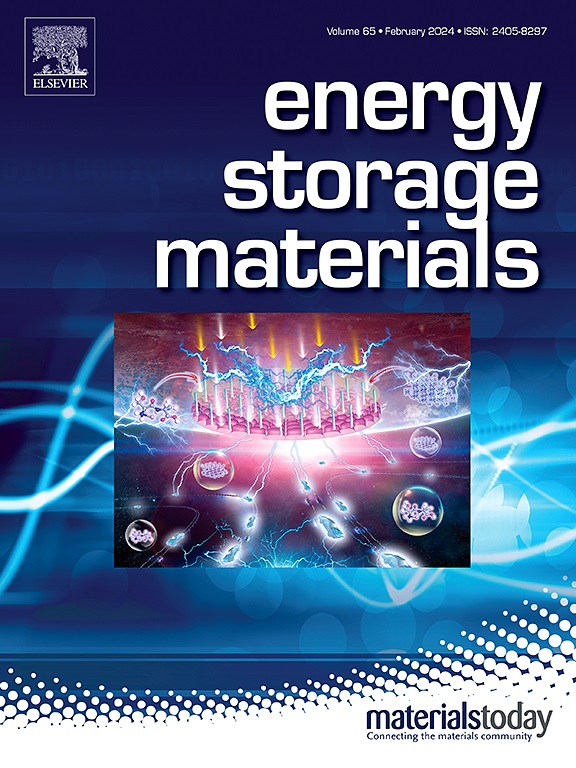Self-cleaning all-fluorinated nonflammable electrolyte for high-voltage and high-temperature Li||NCM811 batteries
IF 18.9
1区 材料科学
Q1 CHEMISTRY, PHYSICAL
引用次数: 0
Abstract
All-fluorinated electrolytes with high oxidation stability and favorable flame-retardant property are promising electrolytes for high-voltage Li metal batteries. However, conventional all-fluorinated electrolytes consisting of fluoroethylene carbonate (FEC) and LiPF6 suffer from grievous decompositions at elevated temperature, which generates reactive species (such as HF and PF5) and seriously damages interfacial structures of electrodes. Herein, we develop a self-cleaning all-fluorinated nonflammable electrolyte, which employes ethoxy(pentafluoro)cyclotriphosphazene (PFPN) to stabilize PF6− via intermolecular interactions, restrain the generation of HF, prevent the decomposition of FEC and enhance thermostability of the electrolyte. The strong interactions between PFPN and other components regulate the solvation structures, and bring more PF6− anions into the primary solvation shell of Li+ to construct solid electrolyte interphases (SEIs) and cathode-electrolyte interphases (CEIs), which leads to the fabrication of robust LiF-rich SEIs/CEIs. Benefiting from the above advantages, the designed electrolyte possesses excellent high-temperature interface compatibility with Li metal anodes and NCM811 cathodes, which endows Li||NCM811 batteries with significantly enhanced cycling stability at 60 °C and high cut-off voltage of 4.5 V. This work provides rational design of highly stable electrolytes for Li metal batteries capable of withstanding aggressive operating conditions.


用于高电压和高温锂电池的自清洁全氟不燃电解质
全氟化电解质具有较高的氧化稳定性和良好的阻燃性能,是高压锂金属电池极具发展前景的电解质。然而,由氟碳酸乙烯(FEC)和LiPF6组成的传统全氟电解质在高温下分解严重,产生HF和PF5等活性物质,严重破坏电极的界面结构。在此,我们开发了一种自清洁的全氟不燃电解质,该电解质采用乙氧基(五氟)环三磷腈(PFPN)通过分子间相互作用稳定PF6 -,抑制HF的产生,防止FEC的分解,提高电解质的热稳定性。pfn与其他组分之间的强相互作用调节了溶剂化结构,使更多的PF6−阴离子进入Li+的初级溶剂化壳层,形成固体电解质界面(SEIs)和阴极电解质界面(CEIs),从而制备出坚固的富锂SEIs/CEIs。得益于上述优点,所设计的电解质与Li金属阳极和NCM811阴极具有良好的高温界面兼容性,使Li||NCM811电池在60℃和4.5 V的高截止电压下具有显著增强的循环稳定性。这项工作为能够承受恶劣工作条件的锂金属电池提供了高稳定电解质的合理设计。
本文章由计算机程序翻译,如有差异,请以英文原文为准。
求助全文
约1分钟内获得全文
求助全文
来源期刊

Energy Storage Materials
Materials Science-General Materials Science
CiteScore
33.00
自引率
5.90%
发文量
652
审稿时长
27 days
期刊介绍:
Energy Storage Materials is a global interdisciplinary journal dedicated to sharing scientific and technological advancements in materials and devices for advanced energy storage and related energy conversion, such as in metal-O2 batteries. The journal features comprehensive research articles, including full papers and short communications, as well as authoritative feature articles and reviews by leading experts in the field.
Energy Storage Materials covers a wide range of topics, including the synthesis, fabrication, structure, properties, performance, and technological applications of energy storage materials. Additionally, the journal explores strategies, policies, and developments in the field of energy storage materials and devices for sustainable energy.
Published papers are selected based on their scientific and technological significance, their ability to provide valuable new knowledge, and their relevance to the international research community.
 求助内容:
求助内容: 应助结果提醒方式:
应助结果提醒方式:


